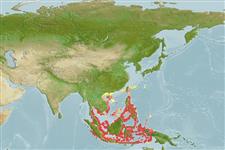Common names from other countries
Environment: milieu / climate zone / depth range / distribution range
Ecologia
. Tropical; 26°N - 9°S, 99°E - 136°E
Western Pacific.
Length at first maturity / Tamanho / Peso / Idade
Maturity: Lm ? range ? - ? cm Max length : 4.0 cm ShL macho/indeterminado; (Ref. 821)
Shell ovate and thick, flatly excavated at the base. Spire small, whorls narrowly rounded with spiral ribs separated by grooves. Columella widely concave, granulated and toothed. Colouration: ribs blue-black, marked with white lines, grooves whitish, spotted with blue black (Ref. 128042).
Collected by gleaning for its edible flesh (Ref. 128042). Length based on occurrence data; to be replaced with better reference. Abundant in rocky shores, forming dense colonies in upper mid-tidal pools, on wet submerged rocks and in crevices. Also found in intertidal areas (Ref. 128042).
Life cycle and mating behavior
Maturidade | Reprodução | Desova | Ovos | Fecundidade | Larvas
Members of the order Neritopsina are mostly gonochoric and broadcast spawners. Life cycle: Embryos develop into planktonic trocophore larvae and later into juvenile veligers before becoming fully grown adults.
Springsteen, F.J. and F.M. Leobrera. 1986. (Ref. 821)
Categoria na Lista Vermelha da IUCN (Ref. 130435)
Categoria CITES (Ref. 108899)
Not Evaluated
Not Evaluated
Utilização humana
| FishSource |
Ferramentas
Fontes da internet
Estimates based on models
Preferred temperature
(Ref.
115969): 28.5 - 29.2, mean 28.8 (based on 552 cells).
Vulnerabilidade
Low vulnerability (10 of 100).
